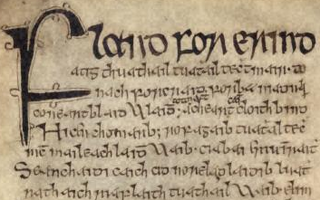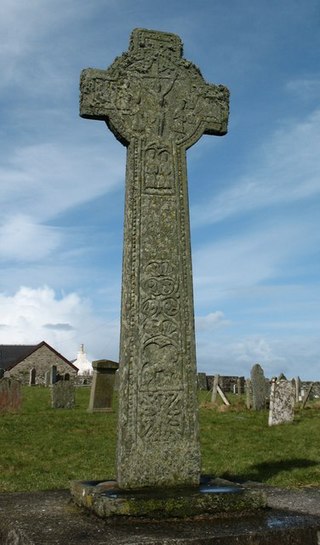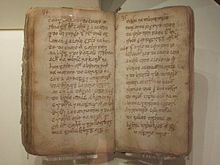
In Celtic cultures, a bard is a professional story teller, verse-maker, music composer, oral historian and genealogist, employed by a patron to commemorate one or more of the patron's ancestors and to praise the patron's own activities.
Leod was the eponymous ancestor and founder of Clan MacLeod and Clan MacLeod of Lewis. Almost nothing is known about him and he does not appear in any contemporary records. Tradition dating to the late 18th century made him a son of Olaf the Black who was King of Man. Heraldic evidence, dating to the late 17th century, is considered to be the earliest evidence of descent from Olaf the Black. However, in recent years, this traditional lineage has been challenged and is no longer considered fact by one historian.
Alasdair mac Mhaighstir Alasdair, legal name Alexander MacDonald, or, in Gaelic Alasdair MacDhòmhnaill, was a Scottish war poet, satirist, lexicographer, political writer and memoirist. The poet's Gaelic name means "Alasdair, son of the Reverend Alasdair". His father, also named Alasdair, was known as Maighstir Alasdair which was then the way of referring to a clergyman in Scottish Gaelic. In English, Maighstir Alasdair was known as the "Reverend Alexander MacDonald".

Clan MacNeacail, sometimes known as Clan MacNicol, is a Scottish clan long associated with the Isle of Skye. Tradition states that, early in its history, the clan held the Isle of Lewis, as well as extensive territory on the north-western mainland. The earliest member of the clan on record is one 14th century John "mak Nakyl", who is recorded amongst Edward I of England's powerful West Highland supporters during the Wars of Scottish Independence. John Barbour's 1375 epic, The Brus, suggests that by 1316, the clan had switched allegiance to Robert I, and made a decisive intervention in the new theatre of Anglo-Scottish conflict in Ireland. The marriage of an heiress to the MacLeods of Lewis brought a severe loss of lands and power in the following generation, forcing the clan chiefs to relocate to the surviving estates on Skye. However, the MacNeacails retained local significant influence: serving, according to tradition, as members of the Council of the Lords of the Isles and as custodians of the cathedral church of the Western Isles at Snizort. In the 17th century, members of the clan began to Anglicise their surname from the Scottish Gaelic MacNeacail to various forms, such as Nicolson. Today the English variants of the Gaelic surname are borne by members of the clan as well as members of unrelated Scottish families, including the Lowland Clan Nicolson.

Clan MacBean, is a highland Scottish clan and is a member and historic sept of Clan Chattan.

The Great Book of Lecan or simply Book of Lecan is a late-medieval Irish manuscript written between 1397 and 1418 in Castle Forbes, Lecan, in the territory of Tír Fhíacrach, near modern Enniscrone, County Sligo. It is in the possession of the Royal Irish Academy. Another date estimate puts the range from c. 1397–1432 or possibly even a little later. David Sellar, who was the Lord Lyon King of Arms in Scotland, concluded that it dates from the early 15th century.

Clan Macfie is a Highlands Scottish Clan.

Domhnall mac Raghnaill was a Hebridean noble in the late 12th and early 13th centuries. He is the eponymous progenitor of Clan Donald. For this reason some traditions accumulated around him in the later Middle Ages and early modern period. His vast impact on culture and in the centuries remains today. Despite his role as the historical figurehead of one of the world's most famous kindreds and surnames, there is almost no contemporary evidence yielding certain information about his life.

Mac Amhlaoibh and Mac Amhalghaidh are two different Gaelic patronymic names with different origins and meanings, but which share the same or similar Anglicisations. These Gaelic names are borne by at least three unrelated native Irish clans or septs.
Scottish Gaelic literature refers to literary works composed in the Scottish Gaelic language, which is, like Irish and Manx, a member of the Goidelic branch of Celtic languages. Gaelic literature was also composed in Gàidhealtachd communities throughout the global Scottish diaspora where the language has been and is still spoken.
Páll, son of Bálki, or Paal Baalkeson, was a 13th-century Hebridean lord who was an ally of Olaf the Black, king of Mann and the Isles. He was long remembered in Gaelic tradition and is traditionally the progenitor of certain families with roots in the Hebrides. Páll is recorded as being a "sheriff" of Skye, a post which had earlier been held by another Páll, son of Bálki, who was possibly an ancestor. This earlier sheriff was said to have been a close friend of Godred II, King of Mann and the Isles.

MS 1467, earlier known as MS 1450, is a mediaeval Gaelic manuscript which contains numerous pedigrees for many prominent Scottish individuals and clans. Transcriptions of the genealogies within the text were first published in the early 19th century and have ever since been used by writers on the clan histories. The 19th century transcriptions and translations from the manuscript have long been considered inadequate; yet there is no modern, scholarly edition of the manuscript.
Clann Somhairle, sometimes anglicised as Clan Sorley, refers to those Scottish and Irish dynasties descending from the famous Norse-Gaelic leader Somerled, King of Mann and the Isles, son of Gillabrigte (†1164) and ancestor of Clann Domhnaill. Primarily they are the Clan Donald, formerly known as the Lord of the Isles, and the mainland Clan MacDougall, and all their numerous branches. Clan Macruari are their lost sept.
Paul Mactire, also known as Paul MacTyre, and Paul M'Tyre, was a 14th-century Scotsman who lived in the north of Scotland. He appears in several contemporary records, as well as in a 15th-century genealogy which records his supposed ancestry. He is known to have married a niece of the brother of the Earl of Ross. According to later tradition, he was a notorious robber, or freebooter in the north of Scotland; and, according to local tradition, he was the builder of a now ruinous fortress in Sutherland. He is said to be the ancestor of several Scottish families. According to some sources Paul Mactire's father was Leod Macgilleandrais.
The White Rod, White Wand, Rod of Inauguration, or Wand of Sovereignty, in the Irish language variously called the slat na ríghe and slat tighearnais, was the primary symbol of a Gaelic king or lord's legitimate authority and the principal prop used in his inauguration ceremony. First documented in the 12th century Life of Máedóc of Ferns, but assumed to have been used long before then, it is last documented in Ireland in the early 17th century. In Scotland the rod was used into the 13th century for the inauguration of its last Gaelic-speaking kings, and for the Norse-Gaelic Lords of the Isles into the 15th.
MacMhuirich is a masculine surname in Scottish Gaelic. The feminine form of the surname is NicMhuirich. The masculine form translates into English as "son of Muireach", and the feminine name translates as "daughter of MacMhuirich". The personal name Muireach means "mariner". The surname has been borne by a noted Hebridean family of bards, who claimed descent from an early 13th-century Irish bard.

The MacMhuirich bardic family, known in Scottish Gaelic as Clann MacMhuirich and Clann Mhuirich, and anglicised as Clan Currie was a prominent family of bards and other professionals in 15th to 18th centuries. The family was centred in the Hebrides, and claimed descent from a 13th-century Irish bard who, according to legend, was exiled to Scotland. The family was at first chiefly employed by the Lords of the Isles as poets, lawyers, and physicians. With the fall of the Lordship of the Isles in the 15th century, the family was chiefly employed by the chiefs of the MacDonalds of Clanranald. Members of the family were also recorded as musicians in the early 16th century, and as clergymen possibly as early as the early 15th century.

Bethóc ingen Somairle was a 13th-century Scottish prioress, considered to have been the first of Iona Nunnery. She was a daughter of Somairle mac Gilla Brigte.

The Beaton medical kindred, also known as Clann Meic-bethad and Clan MacBeth, was a Scottish kindred of professional physicians that practised medicine in the classical Gaelic tradition from the Middle Ages to the Early Modern Era.
The Sleat History, also known as the History of the MacDonalds, is a seventeenth-century historical source documenting the history of Clan Donald.










